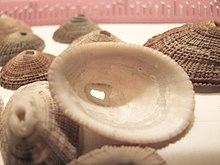Keyhole limpet
| Keyhole limpet Temporal range: Triassic–Recent |
|
|---|---|
 |
|
| A group of shells of Diodora cayenensis | |
| Scientific classification | |
| Kingdom: | Animalia |
| Phylum: | Mollusca |
| Class: | Gastropoda |
| Clade: | Vetigastropoda |
| Superfamily: |
Fissurelloidea Fleming, 1822 |
| Family: |
Fissurellidae Fleming, 1822 |
| Type genus | |
|
Diodora J. E. Gray, 1821 |
|
| Genera and species | |
|
See text |
|
See text
Fissurellidae, common name the keyhole limpets and slit limpets, is a taxonomic family of limpet-like sea snails, marine gastropod molluscs in the clade Vetigastropoda. Their common name derives from the small hole in the apex of their cone-like shells. Although superficially resembling other "true" limpets, they are in fact not closely related to them.
Fissurellidae is the only family in the superfamily Fissurelloidea.
The distribution of fissurellids is world-wide, from cold waters to tropical waters.
Fissurellids live in habitats on and under rocks in the lower intertidal zones to deeper waters.
Keyhole limpets somewhat resemble true limpets because of the simple conical shape of their shells, but in reality they are not closely related to true limpets, which are in the clade Patellogastropoda. This conical shape of the shell allows keyhole limpets to withstand wave attack on exposed rocks. The shell has a reticulate (= net-like) sculpture with strong radial ribs and lacks an operculum. The shell ranges from 3 mm to 13.2 cm. The Great keyhole limpet (Megathura crenulata) measures up to 13.2 cm.
For respiration, the shells of fissurellids have a single apical or subapical perforation ("keyhole"). This opening at the top allows a direct exit of exhalant water currents together with waste products from the mantle cavity. The water enters under the edge of the shell near the head and passes over large paired gills. Most young species in this family have a marginal slit in the middle of the anterior end of the spiral shell. Some species possess just a short internal groove at the anterior end. The paired organs in the mantle cavity represent a primitive condition in gastropods.
...
Wikipedia
